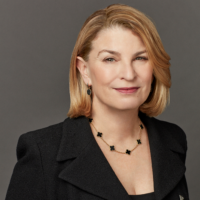“In the Room” with Sally Susman
By Sarah Lynch

Like many of us in March of 2020, Sally Susman packed up her office for two weeks of remote work. Two weeks turned into almost two years, and Pfizer’s Executive Vice President and Chief Corporate Affairs Officer found herself facing a desperate public and a ticking clock in the race for a COVID-19 vaccine.
In the end, Susman played a critical role in the public adoption of the vaccine by strategically communicating under the simple mantra: science is going to win.
Susman spoke with Dustee Jenkins, New York Women in Communications (NYWICI) President and Global Head of Public Affairs at Spotify, for the first “In the Room” event on Dec. 16 at Meredith’s Manhattan headquarters.
Project Light Speed
When the pandemic hit, Pfizer had what Susman calls a “put up or shut up” moment for their new purpose statement: breakthroughs that change patients’ lives.
“Are we going to live up to this purpose statement or not?” Susman asked. That’s how she ended up on Project Light Speed—a group that met at 5 p.m. daily to identify and resolve issues related to COVID-19, working at a never-before-achieved pace for a life-saving vaccine.
The work was non-stop but purpose-driven. Pfizer had embarked on an audacious mission to create a vaccine in eight months, and Susman sat at the helm of that mission’s public dimension. From negotiating with international governments to combating vaccine hesitancy, Pfizer’s communication and media team worked day in and day out to demystify and amplify the company’s work.
Through transparency and storytelling, they strove to bring consumers on the journey, ultimately advancing understanding and adoption.
Transparency & Storytelling
Susman took an approach so transparent that it just about knocked the scientists off of their chairs. Never before had they posted a step-by-step outline of their clinical trials on their website, but Susman did. She wanted the public to understand exactly what went into the trial process.
Equally important, Susman wanted the public to know that it would be science, and not politicians, dictating the timeline for the vaccine. Susman penned a letter for her CEO, Albert Bourla, explicitly stating this—and that their obligation was to the patients. But there was a catch: no media outlet wanted to pick this letter up. Instead, Susman posted to the Pfizer website again, and it went viral.
At every turn, Susman chose the mode of communication that fit their needs rather than what followed tradition. She even communicated often and openly with Pfizer’s direct competition, like Johnson & Johnson. And in addition to her copious responsibilities, Susman took on the de facto role of Chief Documentary Advisor, ensuring a record of Pfizer’s work was captured in real time.
Transparent messages build trust, but storytelling lets those messages resonate. Susman doesn’t call anyone an anti-vaxxer; she believes the term alienates people instead of building a bridge.
“It’s less about facts and figures and more about storytelling and people’s own experiences,” Susman said. “It’s less about politicians, celebrities, sports heroes, and it’s more about your teacher, your neighbor, the barber, the preacher and the person you trust locally.”
And in the midst of it all, Susman’s team took a 171-year-old tradition—the Pfizer logo in the blue bubble—and transformed it, making another decision that defied the playbook. But as Susman says: take the playbook and throw it out, but trust your muscles. The new logo shed the pill-shaped bubble for a double helix—representative of the science at the core of Pfizer’s extraordinary race against the clock.
The Race Continues
With just over 60% of Americans fully vaccinated, herd immunity not yet achieved and variants like Omicron spreading rapidly, Susman’s masterful work to communicate with transparency, consistency and authenticity remains imperative as the world continues to change around us. For Susman though, there is no work she’d rather be doing.
“We’ve been receiving these stories all the time. People send a picture and they say, ‘Saw my grandma for the first time in two years,’ or they send a video of their kid being able to hug another kid, and that is more than any money or compensation,” Susman said. “It’s a really big joy.”

